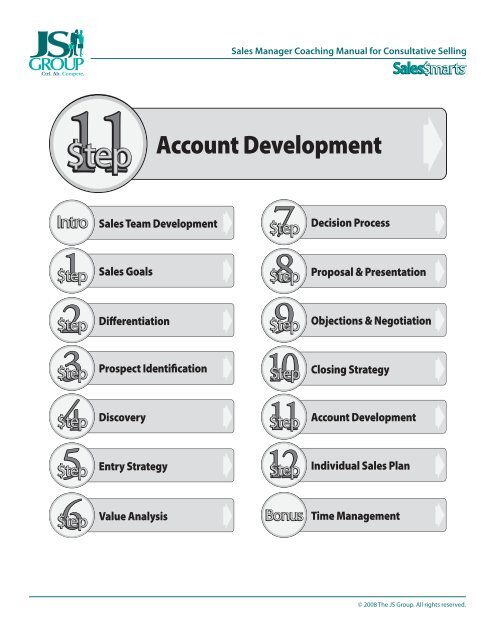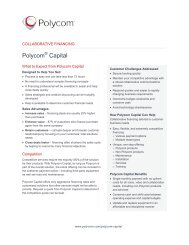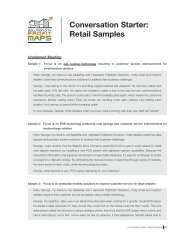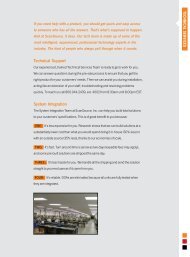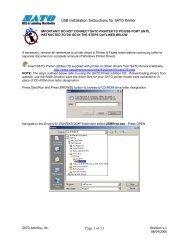Step 11: Account Development Plan Template - ScanSource
Step 11: Account Development Plan Template - ScanSource
Step 11: Account Development Plan Template - ScanSource
Create successful ePaper yourself
Turn your PDF publications into a flip-book with our unique Google optimized e-Paper software.
Sales Manager Coaching Manual for Consultative Selling<br />
<strong>Account</strong> <strong>Development</strong><br />
Sales Team <strong>Development</strong><br />
Decision Process<br />
Sales Goals<br />
Proposal & Presentation<br />
Differentiation<br />
Objections & Negotiation<br />
Prospect Identification<br />
Closing Strategy<br />
Discovery<br />
<strong>Account</strong> <strong>Development</strong><br />
Entry Strategy<br />
Individual Sales <strong>Plan</strong><br />
Value Analysis<br />
Time Management<br />
© 2008 The JS Group. All rights reserved.
Sales Manager Coaching Manual for Consultative Selling<br />
<strong>Step</strong> <strong>11</strong>: <strong>Account</strong> <strong>Development</strong><br />
Objective of <strong>Step</strong> <strong>11</strong><br />
The objective of this step is to learn how to develop a<br />
lasting, profitable relationship with existing customers,<br />
to widen reach in an account and develop a specific,<br />
actionable account plan for the development of each<br />
customer.<br />
As a result, your team will have a good understanding<br />
of not only how to retain customers, but also how to<br />
deepen their relationship with their customers, resulting<br />
in repeat business, referrals, extending their reach into<br />
other departments, and selling additional products and<br />
services.<br />
Determine if staff coaching is needed:<br />
Can your team answer this question?<br />
Do I have the proper type of contacts in all my accounts?<br />
Do I know how to keep an income flow from this customer,<br />
generate references and referrals and create a lasting,<br />
profitable relationship?<br />
Determine actions for yourself:<br />
Are there particular skills, resources, or processes you need<br />
to acquire or put in place for your team to use to develop<br />
their accounts? What are they?<br />
<strong>Step</strong> <strong>11</strong> Content:<br />
It is amazing how few salespeople realized the danger of<br />
reducing their involvement in an account immediately<br />
after a sale is made. So why is <strong>Account</strong> <strong>Development</strong> after<br />
the “sale” so important? Remember that the installation<br />
of your company’s solution is just the beginning of the<br />
relationship! Our research at the JS Group shows that solid<br />
<strong>Account</strong> Relationship <strong>Development</strong> is the single best way<br />
to limit the opportunities for your competitors to “steal”<br />
your valued customers.<br />
But a sales person might say - I’ve got a great product, a<br />
perfect solution to my customer’s business problem, isn’t<br />
that enough to generate business? Shouldn’t I be focusing<br />
on finding new business with new customers? Why should<br />
I focus on developing relationships with my existing<br />
customers?<br />
There are two main reasons:<br />
1. There’s untapped value in your existing<br />
customers.<br />
2. If you don’t take care of your existing customers,<br />
you may lose them.<br />
The figures back this up – those existing customers have<br />
high value to your company. Not only do they spend 33%<br />
more than new customers, but it costs six times more to<br />
sell something to a new customer than to sell that same<br />
thing to a current customer.<br />
However, building a relationship with that one primary<br />
contact the sales person had during the sales process<br />
does not give the sales person the depth they need to<br />
identify the account’s long-term needs. Even if they are<br />
doing GREAT business within a particular company, if<br />
they only have one or even two business contacts there,<br />
your relationship is at risk. What would happen if one of<br />
these key people suddenly left the company? Again, the<br />
numbers tell the tale - The average $25,000 sale in the USA<br />
has 6-8 people engaged in the process – meaning the<br />
sales person needs to know everyone and everyone needs<br />
to know them in order to consistently win sales.<br />
So what do you need to do to coach your team on how to<br />
build contact depth in an account? You need to work with<br />
your team to help them identify the three basic categories<br />
for account contacts:<br />
1.<br />
2.<br />
3.<br />
Purchasers - these are the decision makers, they<br />
sign on the dotted line<br />
Users – the end user, or manager of the end users,<br />
for your solution<br />
Influencers - those who can influence the purchase,<br />
but are not the final decision makers – these can<br />
be external as well as internal influencers<br />
<br />
<strong>Step</strong> <strong>11</strong>: <strong>Account</strong> <strong>Development</strong><br />
© 2008 The JS Group. All rights reserved.
Sales Manager Coaching Manual for Consultative Selling<br />
<strong>Step</strong> <strong>11</strong>: <strong>Account</strong> <strong>Development</strong> (continued)<br />
However, it is not enough for the sales person to have<br />
contacts in each of these three categories. They also need to<br />
make sure they have the right people in the right category<br />
in the right roles. It does not help them to have 3 people all<br />
in finance and none in technology in any one category. So<br />
you must also coach them to look at the role the contact<br />
has in their company - are they the IT Manager, a director,<br />
consultant, engineer or business unit manager?<br />
All of these roles fit into 3 basic areas: Technical, Business<br />
or Finance. And of course, they are all either a Purchaser,<br />
User or Influencer. This means the sales person need a<br />
minimum of 9 contacts to have at least one contact in<br />
each category and role. This will give them the necessary<br />
depth to be able to go back into the account and uncover<br />
additional opportunities for your company.<br />
And once they know who they need, they must be sure<br />
they know how to go about attracting the attention<br />
of these contacts. This means understanding them<br />
and knowing what to say to them about their business<br />
interests, buying process, why they would want to talk to<br />
you and what appeals to them. This is essentially the same<br />
type of information they needed to approach their original<br />
contacts in the first place.<br />
<strong>Account</strong> <strong>Development</strong> <strong>Plan</strong><br />
Now let’s examine the actual process of account<br />
development planning. To do that, think for a moment<br />
about those inactive customer files in the file cabinets<br />
or your team’s customer folders…Why are they inactive?<br />
Where did they go? Did they leave? If so, why?<br />
In general, customers leave for 4 reasons:<br />
1. They perceive pricing as too high or unfair<br />
2. They have an unresolved complaint<br />
3. They accept a competitor’s offer<br />
4. They feel you don’t care about their business<br />
IBM’s founder, Thomas J. Watson, built IBM’s success for years<br />
upon such plans, customer by customer. Watson set targets<br />
for penetration, development and growth. He gathered<br />
detailed information about each customer, and involved<br />
the entire company—not just sales and service. Watson<br />
make sure that product development, manufacturing,<br />
administrative functions, and senior management were<br />
all aligned towards providing a complete solution for each<br />
customer.<br />
On an interesting thing occurred however as IBM’s<br />
competitors tried to imitate IBM’s success. These<br />
competitors didn’t truly understand and buy into the<br />
process. They hired away IBM sales people, but this was<br />
not enough – once out of IBM, these sales people were not<br />
backed by an entire organization dedicated to delivering<br />
the customer’s solutions.<br />
What this comes down to is that your team needs to create<br />
a relationship with their customers so that these customers<br />
become emotionally connected to your company, to<br />
ensure the highest level of customer investment. If a<br />
customer is loyal only to a one-time deal, the relationship<br />
is at risk. Remember that customer relations and sales are<br />
never “steady” or “stable”. They are either getting worse<br />
or getting better. Face the very uncomfortable fact that<br />
no matter how great the service was your team provided<br />
yesterday, IT WAS YESTERDAY.<br />
Customers look to your company to continually provide<br />
evidence of the value of a relationship; if your team can<br />
build that value, they will build sales. The best way to<br />
ensure that each customer is developed into a valued longterm<br />
customer, is to build a formal account development<br />
plan for each and every customer. Use the templates in<br />
the workbook section to help your team build an account<br />
development plan for each of their customers.<br />
<br />
<strong>Step</strong> <strong>11</strong>: <strong>Account</strong> <strong>Development</strong><br />
© 2008 The JS Group. All rights reserved.
Sales Manager Coaching Manual for Consultative Selling<br />
<strong>Step</strong> <strong>11</strong>: <strong>Account</strong> <strong>Development</strong> (continued)<br />
Final Note: The importance of references and referrals.<br />
C-level execs involved in making decisions say the #1<br />
source for a new solution provider is a referral from a peer or<br />
colleague. So, what does this mean? It means that referrals<br />
and positive word-of-mouth are the most effective ways<br />
to build business. When a sales person does a good job<br />
for a customer, that customer will not only bring repeat<br />
business, but will send other business their way as well.<br />
The problem with most salespeople is that they ask a<br />
customer for a referral without first establishing that the<br />
customer would be willing to be a reference. When you<br />
consider this, it sounds illogical…but think, how do you<br />
know a customer thinks you are good enough to refer, if<br />
they are not a reference for you?<br />
So why is it then that so many sales people forget this<br />
all-important step? You need to coach them to ask every<br />
successful customer if they would be a reference for your<br />
company. They should make it clear to their customers<br />
that the experience of working with them was one the<br />
sales person would like to repeat, and that the sales person<br />
would like more customers just like them! And, once the<br />
customer has agreed to serve as a reference, the sales<br />
person can then move the customer towards providing<br />
referrals.<br />
<br />
<strong>Step</strong> <strong>11</strong>: <strong>Account</strong> <strong>Development</strong><br />
© 2008 The JS Group. All rights reserved.
Sales Manager Coaching Manual for Consultative Selling<br />
<strong>Step</strong> <strong>11</strong>: <strong>Account</strong> <strong>Development</strong> - Coaching Session<br />
Coaching Session Content<br />
Exercise 1<br />
Session Objective: Learn to dig deeper in an existing<br />
account by expanding their contact base to find additional<br />
opportunity.<br />
Pre Work Exercise 1<br />
Have each sales person pick one account (a strategic one<br />
is best) and bring a list of their current contacts within that<br />
company to the coaching session.<br />
You need to ensure you have sufficient copies of the<br />
<strong>Account</strong> Contacts Chart on page 5 of <strong>Step</strong> <strong>11</strong> for each<br />
sales person attending the session.<br />
Coaching Session<br />
Action: Start by having them sorting each of their contacts<br />
and placing them in the correct category and role in the<br />
<strong>Account</strong> Contacts Chart. Tell them that their goal is to<br />
have 9 people in the account, one in each category and<br />
role. Have them write strategies for finding the contacts<br />
they are missing and leveraging the ones they do have.<br />
Discussion:<br />
Was there an area where all team members lacked<br />
contacts?<br />
With which of these positions do they have the most/least<br />
success? Explain why.<br />
Consider strategies for locating the needed contacts and<br />
leveraging the current contacts.<br />
Post Session Metrics and KPIs for Measurement As<br />
a result of this coaching session:<br />
• All sales people will increase the number of contacts in<br />
their accounts, resulting in an increase in revenue from<br />
those accounts.<br />
Exercise 2<br />
Session Objective: Understand how to develop a<br />
profitable relationship with an existing customer through<br />
determining fit and value of the customer to your company<br />
and developing objectives and strategies.<br />
Pre Work Exercise 2<br />
“The Lost Customer.”<br />
Have your team go through their old files (or the old files<br />
of a former employee) for a customer that has shown no<br />
activity in quite a while, and bring information on that<br />
customer to the coaching session.<br />
You also need to ensure that you bring sufficient copies of<br />
the <strong>Account</strong> <strong>Development</strong> <strong>Plan</strong> <strong>Template</strong> on pages 6 - 13<br />
of <strong>Step</strong> <strong>11</strong> for each attendee. Or use one you create using<br />
your company’s CRM system.<br />
Coaching Session<br />
Action: Using the <strong>Account</strong> <strong>Development</strong> <strong>Plan</strong> <strong>Template</strong><br />
(or the one you create using your company’s CRM system),<br />
have the team determine where the customer got “lost” in<br />
the relationship process and what could have been done<br />
to keep/develop this customer. Then have them develop a<br />
plan to re-open the relationship with the customer.<br />
Discussion: Discuss ways to resume the relationship<br />
with the customer without loosing the company’s value<br />
position<br />
Post Session Metrics and KPIs for Measurement<br />
As a result of this coaching session:<br />
• All sales people will have an increase in repeat<br />
business as a result of their time spent on<br />
developing existing accounts.<br />
<br />
<strong>Step</strong> <strong>11</strong>: <strong>Account</strong> <strong>Development</strong><br />
© 2008 The JS Group. All rights reserved.
Sales Manager Coaching Manual for Consultative Selling<br />
<strong>Step</strong> <strong>11</strong>: <strong>Account</strong> Contacts Chart<br />
Instructions: List all your current contacts for an account in the appropriate category and role row. For each row, list<br />
either a strategy for finding the contacts you need or the best strategy for developing those contacts you already have.<br />
Use the blank rows to add information on other contacts that are in duplicate categories and roles.<br />
<strong>Account</strong> Company Name: ____________________________________________________________________________<br />
Category Role Contact Name Strategy to Grow Existing or Locate New<br />
P<br />
U<br />
I<br />
P<br />
U<br />
I<br />
P<br />
U<br />
I<br />
T<br />
T<br />
T<br />
B<br />
B<br />
B<br />
F<br />
F<br />
F<br />
Key<br />
Category P=Purchaser U=User I=Influencer<br />
Role T=Technical B=Business F=Financial<br />
<br />
<strong>Step</strong> <strong>11</strong>: <strong>Account</strong> <strong>Development</strong><br />
© 2008 The JS Group. All rights reserved.
Sales Manager Coaching Manual for Consultative Selling<br />
<strong>Step</strong> <strong>11</strong>: <strong>Account</strong> <strong>Development</strong> <strong>Plan</strong> <strong>Template</strong><br />
Customer Name:<br />
<strong>Account</strong> Manager:<br />
______________________________________________________________________________<br />
______________________________________________________________________________<br />
Situation Analysis<br />
Describe your customer, including their industry, size, location, and any other pertinent facts.<br />
__________________________________________________________________________________________________<br />
__________________________________________________________________________________________________<br />
__________________________________________________________________________________________________<br />
__________________________________________________________________________________________________<br />
Outline the current status of your company’s business dealings with this customer.<br />
__________________________________________________________________________________________________<br />
__________________________________________________________________________________________________<br />
__________________________________________________________________________________________________<br />
__________________________________________________________________________________________________<br />
List your key contacts within the customer company, and indicate the “level of investment” this contact has with your company.<br />
(1=deal loyal; 2=brand loyal; 3=emotionally connected)<br />
Contact Name and Title Level of Loyalty Category and Role<br />
Estimate the potential value of this customer for the short term (6 months) and the long term. Describe your estimates.<br />
__________________________________________________________________________________________________<br />
__________________________________________________________________________________________________<br />
__________________________________________________________________________________________________<br />
<br />
<strong>Step</strong> <strong>11</strong>: <strong>Account</strong> <strong>Development</strong><br />
© 2008 The JS Group. All rights reserved.
Sales Manager Coaching Manual for Consultative Selling<br />
<strong>Step</strong> <strong>11</strong>: <strong>Account</strong> <strong>Development</strong> <strong>Plan</strong> <strong>Template</strong> (continued)<br />
Describe why you think your company is uniquely suited to build a relationship with this customer.<br />
__________________________________________________________________________________________________<br />
__________________________________________________________________________________________________<br />
__________________________________________________________________________________________________<br />
__________________________________________________________________________________________________<br />
__________________________________________________________________________________________________<br />
__________________________________________________________________________________________________<br />
__________________________________________________________________________________________________<br />
__________________________________________________________________________________________________<br />
__________________________________________________________________________________________________<br />
__________________________________________________________________________________________________<br />
__________________________________________________________________________________________________<br />
__________________________________________________________________________________________________<br />
Indicate any additional insights you have that may be relevant to your relationship with this customer.<br />
__________________________________________________________________________________________________<br />
__________________________________________________________________________________________________<br />
__________________________________________________________________________________________________<br />
__________________________________________________________________________________________________<br />
__________________________________________________________________________________________________<br />
__________________________________________________________________________________________________<br />
__________________________________________________________________________________________________<br />
__________________________________________________________________________________________________<br />
__________________________________________________________________________________________________<br />
__________________________________________________________________________________________________<br />
__________________________________________________________________________________________________<br />
__________________________________________________________________________________________________<br />
__________________________________________________________________________________________________<br />
__________________________________________________________________________________________________<br />
__________________________________________________________________________________________________<br />
__________________________________________________________________________________________________<br />
<br />
<strong>Step</strong> <strong>11</strong>: <strong>Account</strong> <strong>Development</strong><br />
© 2008 The JS Group. All rights reserved.
Sales Manager Coaching Manual for Consultative Selling<br />
<strong>Step</strong> <strong>11</strong>: <strong>Account</strong> <strong>Development</strong> <strong>Plan</strong> <strong>Template</strong> (continued)<br />
Short Term Objectives<br />
List your overall short-term objectives for this account (next six months). List the strategies you will use to accomplish<br />
this goal. After each strategy write the tactics you will use to accomplish the objective.<br />
Overall Short-Term <strong>Account</strong> Objective:<br />
__________________________________________________________________________________________________<br />
__________________________________________________________________________________________________<br />
__________________________________________________________________________________________________<br />
__________________________________________________________________________________________________<br />
__________________________________________________________________________________________________<br />
__________________________________________________________________________________________________<br />
__________________________________________________________________________________________________<br />
__________________________________________________________________________________________________<br />
__________________________________________________________________________________________________<br />
__________________________________________________________________________________________________<br />
Strategy # 1: _______________________________________________________________________________________<br />
Strategy # 2: _______________________________________________________________________________________<br />
Strategy # 3: _______________________________________________________________________________________<br />
<br />
<strong>Step</strong> <strong>11</strong>: <strong>Account</strong> <strong>Development</strong><br />
© 2008 The JS Group. All rights reserved.
Sales Manager Coaching Manual for Consultative Selling<br />
<strong>Step</strong> <strong>11</strong>: <strong>Account</strong> <strong>Development</strong> <strong>Plan</strong> <strong>Template</strong> (continued)<br />
Short Term Tactics<br />
Instructions: Outline in detail the tactics and activities you plan to implement over the next six months in order to<br />
achieve your short-term objectives. State any dependancies and resources needed to execute the tactic/activity. Include<br />
a target timeframe for each action taken.<br />
Strategy 1:<br />
Tactic/Activity Dependencies and Resources Needed Timeframe<br />
Strategy 2:<br />
Tactic/Activity Dependencies and Resources Needed Timeframe<br />
Strategy 1:<br />
Tactic/Activity Dependencies and Resources Needed Timeframe<br />
<br />
<strong>Step</strong> <strong>11</strong>: <strong>Account</strong> <strong>Development</strong><br />
© 2008 The JS Group. All rights reserved.
Sales Manager Coaching Manual for Consultative Selling<br />
<strong>Step</strong> <strong>11</strong>: <strong>Account</strong> <strong>Development</strong> <strong>Plan</strong> <strong>Template</strong> (continued)<br />
Short Term Measurements<br />
Indicate the KPIs you will use to measure the success of each strategy.<br />
Strategy 1 KPI - Input KPI – Output<br />
Strategy 2 KPI - Input KPI – Output<br />
Strategy 3 KPI - Input KPI – Output<br />
10 <strong>Step</strong> <strong>11</strong>: <strong>Account</strong> <strong>Development</strong><br />
© 2008 The JS Group. All rights reserved.
Sales Manager Coaching Manual for Consultative Selling<br />
<strong>Step</strong> <strong>11</strong>: <strong>Account</strong> <strong>Development</strong> <strong>Plan</strong> <strong>Template</strong> (continued)<br />
Long Term Objectives and Strategies<br />
List your overall long-term objectives for this account over the next year. List the strategies you will use to accomplish<br />
this goal. After each strategy write the tactics you will use to accomplish the objective.<br />
Overall Long-Term <strong>Account</strong> Objective:<br />
__________________________________________________________________________________________________<br />
__________________________________________________________________________________________________<br />
__________________________________________________________________________________________________<br />
__________________________________________________________________________________________________<br />
__________________________________________________________________________________________________<br />
__________________________________________________________________________________________________<br />
__________________________________________________________________________________________________<br />
__________________________________________________________________________________________________<br />
__________________________________________________________________________________________________<br />
__________________________________________________________________________________________________<br />
Strategy # 1: _______________________________________________________________________________________<br />
Strategy # 2: _______________________________________________________________________________________<br />
Strategy # 3: _______________________________________________________________________________________<br />
<strong>11</strong> <strong>Step</strong> <strong>11</strong>: <strong>Account</strong> <strong>Development</strong><br />
© 2008 The JS Group. All rights reserved.
Sales Manager Coaching Manual for Consultative Selling<br />
<strong>Step</strong> <strong>11</strong>: <strong>Account</strong> <strong>Development</strong> <strong>Plan</strong> <strong>Template</strong> (continued)<br />
Long Term Tactics<br />
Instructions: Outline in detail the tactics and activities you plan to implement in order to achieve your long-term<br />
objectives. State any dependencies and resources needed to execute the tactic/activity. Include a target timeframe for<br />
each action taken.<br />
Strategy 1:<br />
Tactic/Activity Dependencies and Resources Needed Timeframe<br />
Strategy 2:<br />
Tactic/Activity Dependencies and Resources Needed Timeframe<br />
12 <strong>Step</strong> <strong>11</strong>: <strong>Account</strong> <strong>Development</strong><br />
© 2008 The JS Group. All rights reserved.
Sales Manager Coaching Manual for Consultative Selling<br />
<strong>Step</strong> <strong>11</strong>: <strong>Account</strong> <strong>Development</strong> <strong>Plan</strong> <strong>Template</strong> (continued)<br />
Long Term Measurements<br />
Indicate the KPIs you will use to measure the success of each strategy.<br />
Strategy 1 KPI - Input KPI – Output<br />
Strategy 2 KPI - Input KPI – Output<br />
Strategy 3 KPI - Input KPI – Output<br />
13 <strong>Step</strong> <strong>11</strong>: <strong>Account</strong> <strong>Development</strong><br />
© 2008 The JS Group. All rights reserved.


